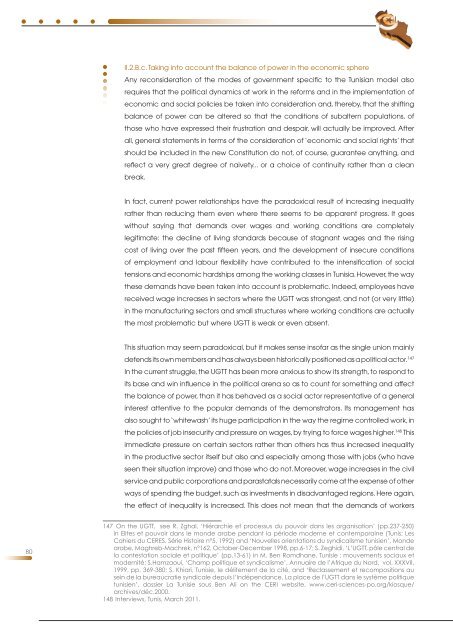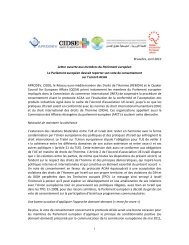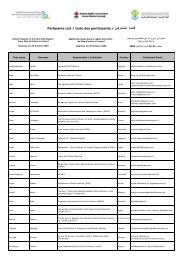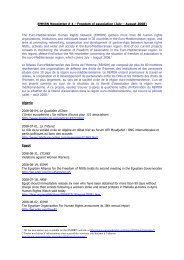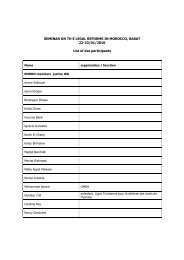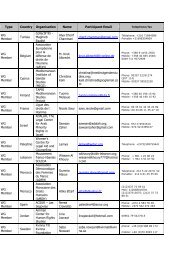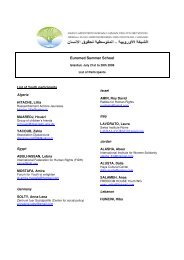tunisia after 14 january and its social and political economy - Refworld
tunisia after 14 january and its social and political economy - Refworld
tunisia after 14 january and its social and political economy - Refworld
You also want an ePaper? Increase the reach of your titles
YUMPU automatically turns print PDFs into web optimized ePapers that Google loves.
II.2.B.c. Taking into account the balance of power in the economic sphereAny reconsideration of the modes of government specific to the Tunisian model alsorequires that the <strong>political</strong> dynamics at work in the reforms <strong>and</strong> in the implementation ofeconomic <strong>and</strong> <strong>social</strong> policies be taken into consideration <strong>and</strong>, thereby, that the shiftingbalance of power can be altered so that the conditions of subaltern populations, ofthose who have expressed their frustration <strong>and</strong> despair, will actually be improved. Afterall, general statements in terms of the consideration of ‘economic <strong>and</strong> <strong>social</strong> rights’ thatshould be included in the new Constitution do not, of course, guarantee anything, <strong>and</strong>reflect a very great degree of naivety... or a choice of continuity rather than a cleanbreak.In fact, current power relationships have the paradoxical result of increasing inequalityrather than reducing them even where there seems to be apparent progress. It goeswithout saying that dem<strong>and</strong>s over wages <strong>and</strong> working conditions are completelylegitimate: the decline of living st<strong>and</strong>ards because of stagnant wages <strong>and</strong> the risingcost of living over the past fifteen years, <strong>and</strong> the development of insecure conditionsof employment <strong>and</strong> labour flexibility have contributed to the intensification of <strong>social</strong>tensions <strong>and</strong> economic hardships among the working classes in Tunisia. However, the waythese dem<strong>and</strong>s have been taken into account is problematic. Indeed, employees havereceived wage increases in sectors where the UGTT was strongest, <strong>and</strong> not (or very little)in the manufacturing sectors <strong>and</strong> small structures where working conditions are actuallythe most problematic but where UGTT is weak or even absent.This situation may seem paradoxical, but it makes sense insofar as the single union mainlydefends <strong>its</strong> own members <strong>and</strong> has always been historically positioned as a <strong>political</strong> actor. <strong>14</strong>7In the current struggle, the UGTT has been more anxious to show <strong>its</strong> strength, to respond to<strong>its</strong> base <strong>and</strong> win influence in the <strong>political</strong> arena so as to count for something <strong>and</strong> affectthe balance of power, than it has behaved as a <strong>social</strong> actor representative of a generalinterest attentive to the popular dem<strong>and</strong>s of the demonstrators. Its management hasalso sought to ‘whitewash’ <strong>its</strong> huge participation in the way the regime controlled work, inthe policies of job insecurity <strong>and</strong> pressure on wages, by trying to force wages higher. <strong>14</strong>8 Thisimmediate pressure on certain sectors rather than others has thus increased inequalityin the productive sector <strong>its</strong>elf but also <strong>and</strong> especially among those with jobs (who haveseen their situation improve) <strong>and</strong> those who do not. Moreover, wage increases in the civilservice <strong>and</strong> public corporations <strong>and</strong> parastatals necessarily come at the expense of otherways of spending the budget, such as investments in disadvantaged regions. Here again,the effect of inequality is increased. This does not mean that the dem<strong>and</strong>s of workers80<strong>14</strong>7 On the UGTT, see R. Zghal, ‘Hiérarchie et processus du pouvoir dans les organisation’ (pp.237-250)in Elites et pouvoir dans le monde arabe pendant la période moderne et contemporaine (Tunis: LesCahiers du CERES, Série Histoire n°5, 1992) <strong>and</strong> ‘Nouvelles orientations du syndicalisme tunisien’, Mondearabe, Maghreb-Machrek, n°162, October-December 1998, pp.6-17; S. Zeghidi, ‘L’UGTT, pôle central dela contestation <strong>social</strong>e et politique’ (pp.13-61) in M. Ben Romdhane, Tunisie : mouvements sociaux etmodernité; S.Hamzaoui, ‘Champ politique et syndicalisme’, Annuaire de l’Afrique du Nord, vol. XXXVII,1999, pp. 369-380; S. Khiari, Tunisie, le délitement de la cité, <strong>and</strong> ‘Reclassement et recompositions ausein de la bureaucratie syndicale depuis l’Indépendance. La place de l’UGTT dans le système politiquetunisien’, dossier La Tunisie sous Ben Ali on the CERI website, www.ceri-sciences-po.org/kiosque/archives/déc.2000.<strong>14</strong>8 Interviews, Tunis, March 2011.


